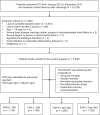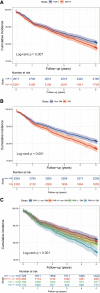High fibrinogen-to-albumin ratio with type 2 diabetes mellitus is associated with poor prognosis in patients undergoing percutaneous coronary intervention: 5-year findings from a large cohort
- PMID: 35313877
- PMCID: PMC8939137
- DOI: 10.1186/s12933-022-01477-w
High fibrinogen-to-albumin ratio with type 2 diabetes mellitus is associated with poor prognosis in patients undergoing percutaneous coronary intervention: 5-year findings from a large cohort
Abstract
Background: Inflammation plays a crucial role in coronary atherosclerosis progression, and growing evidence has demonstrated that the fibrinogen-to-albumin ratio (FAR), as a novel inflammation biomarker, is associated with the severity of coronary artery disease (CAD). However, the long-term risk of cardiovascular events remains indistinct in patients with different level of FAR and different glycemic metabolism status. This study was to assess 5-year clinical outcomes of diabetic and non-diabetic patients who underwent percutaneous coronary intervention (PCI) with different level of FAR.
Methods: We consecutively enrolled 10,724 patients with CAD hospitalized for PCI and followed up for the major adverse cardiac and cerebrovascular events (MACCE) covering all-cause mortality, cardiac mortality, non-fatal myocardial infarction, non-fatal ischemic stroke, and unplanned coronary revascularization. FAR was computed using the following formula: Fibrinogen (g/L)/Albumin (g/L). According to the optimal cut-off value of FAR for MACCE prediction, patients were divided into higher level of FAR (FAR-H) and lower level of FAR (FAR-L) subgroups, and were further categorized into four groups as FAR-H with DM and non-DM, and FAR-L with DM and non-DM.
Results: 5298 patients (58.36 ± 10.36 years, 77.7% male) were ultimately enrolled in the present study. A total of 1099 (20.7%) MACCEs were documented during the 5-year follow-up. The optimal cut-off value of FAR was 0.0783 by the surv_cutpoint function. Compared to ones with FAR-H and DM, patients with FAR-L and non-DM, FAR-H and non-DM, FAR-L and DM had decreased risk of MACCEs [adjusted hazard ratio (HR): 0.75, 95% confidence interval (CI) 0.64-0.89, P = 0.001; HR: 0.78, 95% CI 0.66-0.93, P = 0.006; HR: 0.81, 95% CI 0.68-0.97, P = 0.019; respectively]. Notably, non-diabetic patients with lower level of FAR also had lower all-cause mortality and cardiac mortality risk than those in the FAR-H/DM group (HR: 0.41, 95% CI 0.27-0.63, P < 0.001; HR: 0.30, 95% CI 0.17-0.53, P < 0.001; respectively). Multivariate Cox proportional hazards regression analysis also indicated the highest risk of MACCEs in patients with FAR-H and DM than others (P for trend = 0.005). In addition, post-hoc analysis revealed consistent effects on 5-year MACCE across various subgroups.
Conclusion: In this real-world cohort study, higher level of FAR combined with DM was associated with worse 5-year outcomes among patients with CAD undergoing PCI. The level of FAR may help to identify high-risk individuals in this specific population, where more precise risk assessment should be performed.
Keywords: Fibrinogen‑to‑albumin ratio; Percutaneous coronary intervention; Prognosis; Type 2 diabetes mellitus.
© 2022. The Author(s).
Conflict of interest statement
The authors declare that they have no conflict of interest.
Figures




Similar articles
-
High neutrophil to lymphocyte ratio with type 2 diabetes mellitus predicts poor prognosis in patients undergoing percutaneous coronary intervention: a large-scale cohort study.Cardiovasc Diabetol. 2022 Aug 13;21(1):156. doi: 10.1186/s12933-022-01583-9. Cardiovasc Diabetol. 2022. PMID: 35964050 Free PMC article.
-
Prognostic value of fibrinogen in patients with coronary artery disease and prediabetes or diabetes following percutaneous coronary intervention: 5-year findings from a large cohort study.Cardiovasc Diabetol. 2021 Jul 16;20(1):143. doi: 10.1186/s12933-021-01335-1. Cardiovasc Diabetol. 2021. PMID: 34271936 Free PMC article.
-
Prognostic value of fibrinogen-to-albumin ratio combined with coronary calcification score in patients with suspected coronary artery disease.BMC Cardiovasc Disord. 2023 Apr 4;23(1):181. doi: 10.1186/s12872-023-03193-z. BMC Cardiovasc Disord. 2023. PMID: 37016312 Free PMC article.
-
Short- and long-term cardiovascular outcomes in insulin-treated versus non-insulin-treated diabetes mellitus patients after percutaneous coronary intervention: A systematic review and meta-analysis.Indian Heart J. 2022 Jan-Feb;74(1):13-21. doi: 10.1016/j.ihj.2021.12.004. Epub 2021 Dec 11. Indian Heart J. 2022. PMID: 34906538 Free PMC article.
-
Stroke Rates Following Surgical Versus Percutaneous Coronary Revascularization.J Am Coll Cardiol. 2018 Jul 24;72(4):386-398. doi: 10.1016/j.jacc.2018.04.071. J Am Coll Cardiol. 2018. PMID: 30025574
Cited by
-
Multi-omics analysis reveals immunosuppression in oesophageal squamous cell carcinoma induced by creatine accumulation and HK3 deficiency.Genome Med. 2025 May 6;17(1):44. doi: 10.1186/s13073-025-01465-1. Genome Med. 2025. PMID: 40329370 Free PMC article.
-
The potential value of fibrinogen to albumin ratio (FAR) in the assessment of inflammation in spondyloarthritis.BMC Musculoskelet Disord. 2022 Sep 15;23(1):864. doi: 10.1186/s12891-022-05797-6. BMC Musculoskelet Disord. 2022. PMID: 36109740 Free PMC article.
-
The Ratio of Fibrinogen to Albumin is Related to the Occurrence of Retinopathy in Type 2 Diabetic Patients.Diabetes Metab Syndr Obes. 2023 Jun 23;16:1859-1867. doi: 10.2147/DMSO.S407391. eCollection 2023. Diabetes Metab Syndr Obes. 2023. PMID: 37384130 Free PMC article.
-
Fibrinogen/albumin ratio is associated with first-ever cardiovascular events in patients with peritoneal dialysis.Ann Med. 2025 Dec;57(1):2499025. doi: 10.1080/07853890.2025.2499025. Epub 2025 Apr 30. Ann Med. 2025. PMID: 40304666 Free PMC article.
-
Correlation of Fibrinogen-Albumin Ratio With Gensini Score in ST-Segment Elevation Myocardial Infarction.Cureus. 2025 Jul 19;17(7):e88317. doi: 10.7759/cureus.88317. eCollection 2025 Jul. Cureus. 2025. PMID: 40837914 Free PMC article.
References
-
- Sharif S, Van der Graaf Y, Cramer MJ, Kapelle LJ, de Borst GJ, Visseren FLJ, Westerink J. Low-grade inflammation as a risk factor for cardiovascular events and all-cause mortality in patients with type 2 diabetes. Cardiovasc Diabetol. 2021;20(1):220. doi: 10.1186/s12933-021-01409-0. - DOI - PMC - PubMed
Publication types
MeSH terms
Substances
Grants and funding
- Grant No. 81900323/National Natural Science Foundation of China
- No. 81770365/National Natural Science Foundation of China
- 2016YFC1301300 and 2016YFC1301301/the Ministry of Science and Technology of the People's Republic of China
- Grant No.NCRC2020013/National Clinical Research Center for Cardiovascular Diseases, Fuwai Hospital, Chinese Academy of Medical SciencesGrant
- 2020-I2M-C&T-B-049/the CAMS Innovation Fund for Medical Sciences (CIFMS)
LinkOut - more resources
Full Text Sources
Medical
Miscellaneous

